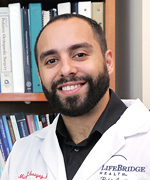Bone Defects from Trauma, Tumors and Infection
What are bone defects?
Bone defects are missing segments of bone. Segmental bone defects may arise for multiple reasons including trauma (injury), tumors and/or infection (osteomyelitis). Bone defects can be classified as small (less than 7 cm or 2.8 in), large (7-12 cm or 2.7-4.7 in), and massive (greater than 12 cm or 4.7 in).
How are bone defects treated?
No single method of bone defect treatment is ideal for every case. Surgeons must carefully consider the advantages and disadvantages of each of the following methods in order to optimize reconstructive options. There are four main treatment options:
- Bone transport (gradually moving one piece of bone within its segment) requires technical expertise readily available at the Rubin Institute’s International Center for Limb Lengthening. Classic bone transport involves cutting the bone near one end of the bone (metaphysis) and gradually moving it down by using either an external fixator or internal nail as new bone (regenerate) grows to fill the space. The choice depends on defect size, as well as other associated problems and obstacles. Bone grafting may be required to optimize healing.
- A second treatment option is shortening and then lengthening, (fixing the bone short and making up the length with lengthening alone).
- The induced membrane technique is a third treatment option. In the induced membrane (Masquelet) technique, temporary antibiotic cement is placed to eliminate bacteria and initiate the healing response, and then the cement is removed and replaced with bone graft.
- Another rarer treatment option is a microvascular bone free flap, (e.g., free fibula transfer after a tumor resection). This is when part of a bone and blood vessels are transferred out of one area of the body and moved to another location of the body where they are needed.
Each of these treatment options has relative advantages and disadvantages depending on defect size, the condition of skin, muscles and tendons, the presence or absence of infection and associated risks.
Why choose the International Center for Limb Lengthening for treatment of bone defects?
Your doctor at the International Center for Limb Lengthening will take the time to make sure you understand all your options and then will customize your treatment to meet your specific needs. Our patients benefit from our team-centered approach with world-renowned surgeons and specialized physician assistants, nurses and physical therapists. We help patients with bone defects achieve their best possible result.
Doctors who treat bone defects
*Patients Over 16 Years Old Only
†Children and Adolescents/Young Adults Only






